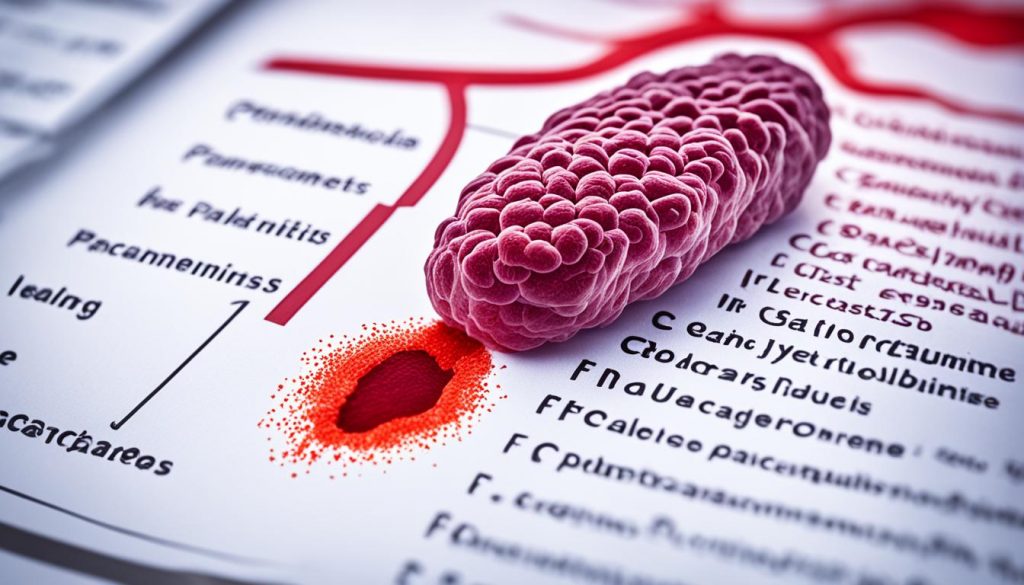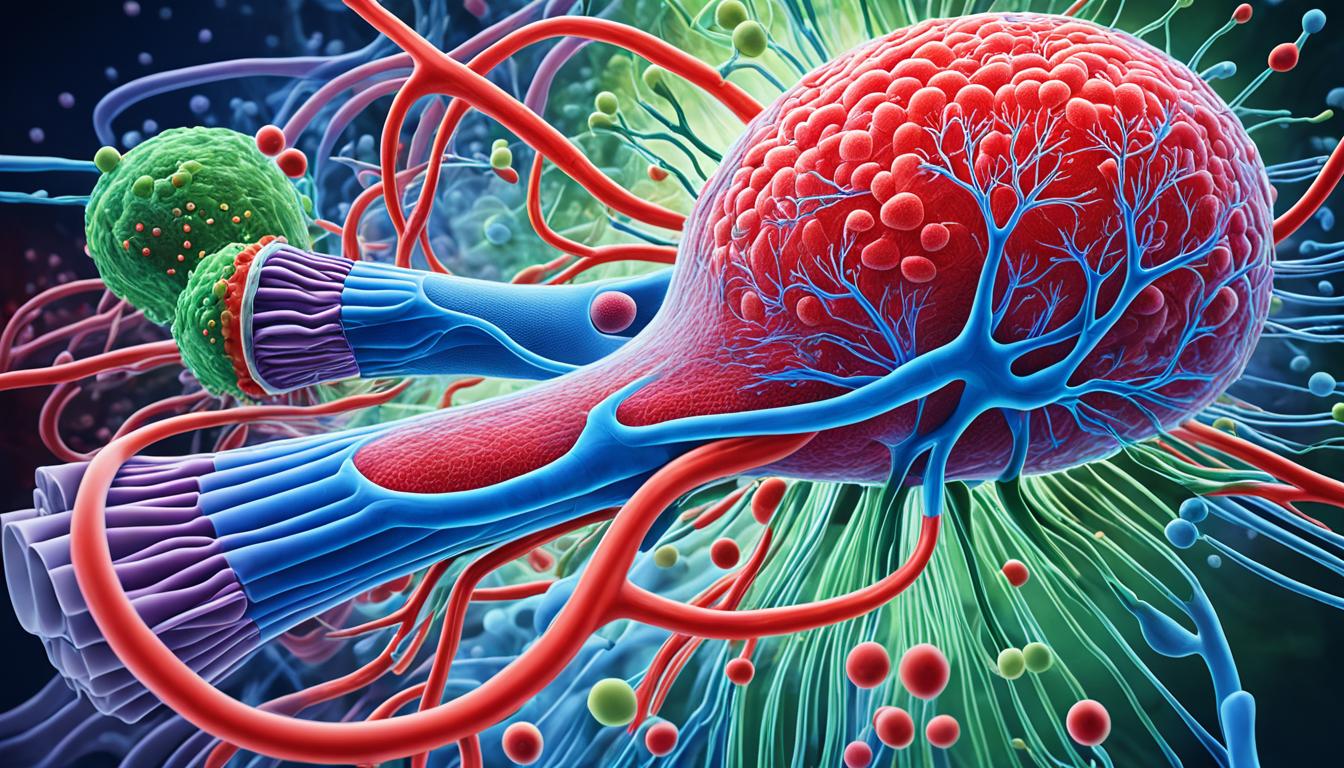Welcome! This guide will cover autoimmune pancreatitis disease. We’ll talk about its symptoms, causes, diagnosis, and treatment. We’ll also look at stem cell therapy’s potential to help with this condition. Understanding autoimmune pancreatitis is key for its proper diagnosis and treatment.
Key Takeaways:
- Autoimmune pancreatitis is an inflammation in the pancreas caused by the immune system attacking healthy pancreatic tissue.
- It is important to differentiate autoimmune pancreatitis from pancreatic cancer due to overlapping symptoms.
- Common symptoms of autoimmune pancreatitis include abdominal pain, weight loss, dark urine, pale stools, and jaundice.
- Risk factors for autoimmune pancreatitis include age, gender, and the presence of inflammatory bowel disease.
- Diagnosis involves imaging tests, blood tests, and in some cases, an endoscopic core biopsy.
- Treatment options for autoimmune pancreatitis include steroids, immunosuppressive drugs, and pancreatic enzyme supplementation.
- Stem cell therapy holds promise in regenerating pancreatic tissue and improving outcomes for individuals with autoimmune pancreatitis.
Symptoms of Autoimmune Pancreatitis
Autoimmune pancreatitis is complex and may not always show obvious symptoms. But when symptoms do show up, they can look like those of pancreatic cancer. It’s key to know these symptoms for quick diagnosis and right treatment. Signs can include:
- Dark urine: Urine might look dark for some with this condition. This happens because of increased bilirubin, a yellow pigment, when bile ducts are blocked.
- Pale stools: Stools can turn pale because of bile flow issues. Normally, bile makes stool brown, but disruption leads to clay-colored stools.
- Jaundice: This shows as yellow skin and eyes. It’s due to bilirubin buildup from blocked bile ducts impacting the liver.
- Abdominal pain: Pain might be felt in the upper belly or middle back. Its intensity and frequency can vary.
- Weight loss: Losing weight without trying is common. Inflammation and digestive changes can reduce appetite, leading to weight loss.
- Nausea and vomiting: Feeling sick and throwing up, especially after eating, can occur with this condition.
Diagnosing Autoimmune Pancreatitis
Diagnosing autoimmune pancreatitis is tricky due to symptom overlaps with other illnesses. Doctors use various tests for an accurate verdict. Tests can be:
- Blood tests: These measure pancreatic enzymes and inflammation markers in the blood.
- Imaging tests: CT scans, MRIs, or ultrasounds help see the pancreas and nearby organs more clearly.
- Endoscopic core biopsy: A small tissue sample taken during an endoscopic procedure can sometimes be crucial for confirmation.
By looking at symptoms and running tests, healthcare providers can diagnose the condition. They then devise the right plan to help those with autoimmune pancreatitis.
Causes and Risk Factors of Autoimmune Pancreatitis
The cause of autoimmune pancreatitis is not clear, but experts think the immune system is to blame. They believe the immune system mistakenly attacks the pancreas. This causes inflammation and harm to the pancreatic tissue. Those with autoimmune pancreatitis have a malfunctioning immune system.
Autoimmune pancreatitis has two subtypes: type 1 and type 2. Type 1 is often found in people over 60, mainly in males. Type 2 affects both men and women and can be linked to inflammatory bowel disease (IBD), like ulcerative colitis. If someone has IBD, they are more likely to get autoimmune pancreatitis.
The reasons for getting autoimmune pancreatitis are still unknown. But, there are things that might make a person more likely to develop it. Some of these risk factors include:
- Age: The risk goes up with age, especially after 60.
- Gender plays a role. Type 1 is more seen in males, while both men and women can get type 2.
- Having an IBD, such as ulcerative colitis, raises the chance of getting autoimmune pancreatitis.
These factors don’t mean someone will definitely get this condition. They just show what might raise the chance. More studies are necessary to understand how these factors and autoimmune pancreatitis are connected.
Complications of Autoimmune Pancreatitis
Autoimmune pancreatitis might cause multiple issues, but knowing about them helps deal with it better.
Pancreatic Exocrine Insufficiency
One issue is when the pancreas can’t make enough digestive enzymes. This makes the body not absorb nutrients well. People might have diarrhea, lose weight, and lack key nutrients.
Diabetes
Autoimmune pancreatitis can harm the pancreas, leading to diabetes. The pancreas makes insulin that balances blood sugar. So, some may need to manage their blood sugar.
Pancreatic and Bile Duct Narrowing
This illness can also narrow the ducts in the pancreas and bile. When they’re blocked, you might see jaundice or ground urine. It’s key to treat these symptoms fast to stop worse ones happening.
Pancreatic Calcifications
Some folks might get pancreatic calcifications, where calcium builds up. This can mess with how the pancreas works. Doctors need to diagnose and treat this condition.
Development of Abnormal Masses
Abnormal masses in the pancreas are another issue. They might lead to more problems. Depending on what they are, they could need treatment or just watching.
Even though these complications are serious, treatment usually means a normal life span for those with autoimmune pancreatitis. It’s also good to know this condition is not linked with pancreatic cancer.
Here is a picture of what pancreatic calcifications look like, a complication of autoimmune pancreatitis.
To manage this condition, watch your symptoms and see a doctor as needed. Following your treatment plan can help you avoid severe complications and enjoy a better life.
When to Seek Medical Attention for Autoimmune Pancreatitis
Autoimmune pancreatitis might not show obvious signs early on. But, it’s crucial to see a doctor if you notice certain symptoms. Certain signs should warn you to get medical help.
Unexplained Weight Loss
If you’re losing weight and you don’t know why, it might be autoimmune pancreatitis. You might think you’re eating fine, but the pounds keep dropping off.
Abdominal Pain
Autoimmune pancreatitis can cause pain in your upper belly or back. This pain might stay constant or come and go. It could get worse after meals or when you’re lying down.
Jaundice
If your skin or eyes turn yellow, that’s called jaundice. It’s a common sign of autoimmune pancreatitis. Jaundice happens when your bile ducts get blocked and bilirubin builds up.
Other Symptoms
There are more signs, like dark urine, pale stools, nausea, and being sick. Plus, you might just not feel right. Each person might have different symptoms. But, if any of these sound like you, see a doctor right away.
If any of these symptoms are concerning, or you’re worried about your health, reach out to a healthcare provider. They can give you the right diagnosis and treatment.

Diagnosis of Autoimmune Pancreatitis
Figuring out if someone has autoimmune pancreatitis is tricky because its symptoms are similar to other conditions. But, doctors have ways to check for it.
They might first do imaging tests like CT scans and MRIs. These tests show the pancreas in detail. They can spot any issues or swelling that might mean autoimmune pancreatitis. CT scans are very good at this.
Next, blood tests are important. They look for high levels of IgG4 in the blood. If these levels are high, it might mean the person has autoimmune pancreatitis, specifically type 1.
If it’s still not clear, a procedure called an endoscopic core biopsy might be needed. This procedure takes a small sample from the pancreas using an endoscope. Doctors then study this sample under a microscope to look for signs of autoimmune pancreatitis.
Doctors combine all these methods to make a confident diagnosis. This helps them create a treatment plan that fits the person’s needs.
Treatment of Autoimmune Pancreatitis
There are effective treatments for autoimmune pancreatitis. The main goal is to lower inflammation and control symptoms. The plan depends on what’s going on with each person and their symptoms.
Steroids: Reducing Inflammation
Prednisone and other steroids are key for managing this condition. They cut down inflammation in the pancreas, which eases pain and other symptoms. People usually take these steroids by mouth. The dose is lowered slowly based on how the person is doing and how bad the illness is.
Immunosuppressive Drugs: Preventing Relapses
Doctors might add immunosuppressive drugs with the steroids to avoid disease coming back. These drugs lower the immune system’s activity. This reduces the chance the immune system will attack the pancreas. Azathioprine and mycophenolate mofetil are two types of these drugs.
Pancreatic Enzyme Supplementation: Alleviating Symptoms
Autoimmune pancreatitis can weaken the pancreas’ ability to make digestive enzymes. This can lead to problems like diarrhea, losing weight, and lacking important nutrients. Using supplements that help with digestion can make a big difference. They help the body digest food better and take in more nutrients.
More treatments might be needed if other issues or illnesses come up. It’s important to team up with a healthcare provider. Together, you can plan a treatment that fits your specific needs and deals with autoimmune pancreatitis.
| Treatment Options | Description |
|---|---|
| Steroids | Medication used to reduce inflammation in the pancreas |
| Immunosuppressive Drugs | Drugs that suppress the immune response to prevent relapses |
| Pancreatic Enzyme Supplementation | Supplements that help improve digestion and alleviate symptoms of pancreatic exocrine insufficiency |
Stem Cell Therapy for Autoimmune Pancreatitis
Stem cell therapy is now a leading option for those with autoimmune pancreatitis and similar issues. It uses the potential of stem cells to fix pancreatitis’s damage and boost pancreatic health.
This tactic is quite new. It plants healthy stem cells in the pancreas to trigger repairs and new cell growth. Consequently, pancreatic function improves, easing symptoms of autoimmune pancreatitis.
Another technique includes are islet cell transplants. These transplants can replace the pancreas’s insulin-producing cells. This aids in diabetes management and betters the pancreas’s health overall.
These advanced stem cell methods are changing the game for autoimmune pancreatitis patients. Stem cells offer real possibilities for improving life quality for those with this condition.
Benefits of Stem Cell Therapy for Autoimmune Pancreatitis:
- Promotes pancreas regeneration
- Restores normal pancreatic function
- Alleviates symptoms of autoimmune pancreatitis
- Manages diabetes associated with pancreatic damage
- Offers potential for improved quality of life
| Treatment | Advantages |
|---|---|
| Stem Cell Therapy |
|
| Islet Cell Transplants |
|
Conclusion
Autoimmune pancreatitis is like pancreatic cancer but not the same. It’s hard to deal with but new treatments give hope. Using things like steroids, drugs to stop the immune system, and stem cells help a lot.
It’s important to catch this disease early. Get help fast if you lose weight without trying, have tummy pain, get yellow skin or eyes, or have other worrying signs. Quick treatment can help a lot. This might be medicine, talking to someone, or changing how you live.
Stem cell therapy is new and sounds very promising. It tries to make the pancreas work like it should and fixes any harm. Getting new cells for your pancreas could mean even better care and chances of getting well.
So, though dealing with autoimmune pancreatitis can be tough, there are more ways to treat it now. Finding the problem fast, getting help early, and managing treatment well can lead to better health. People can truly hope for a better future.

